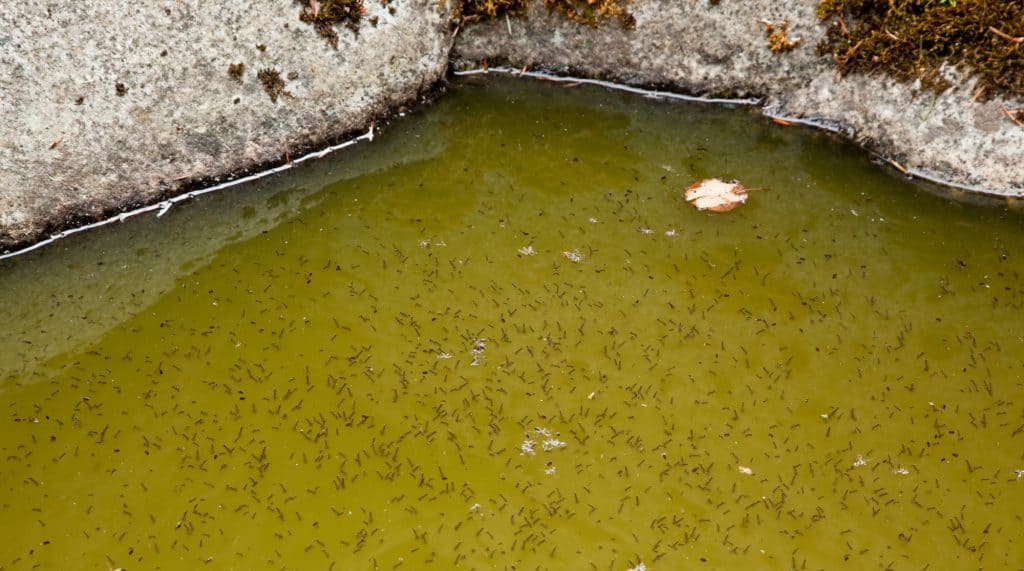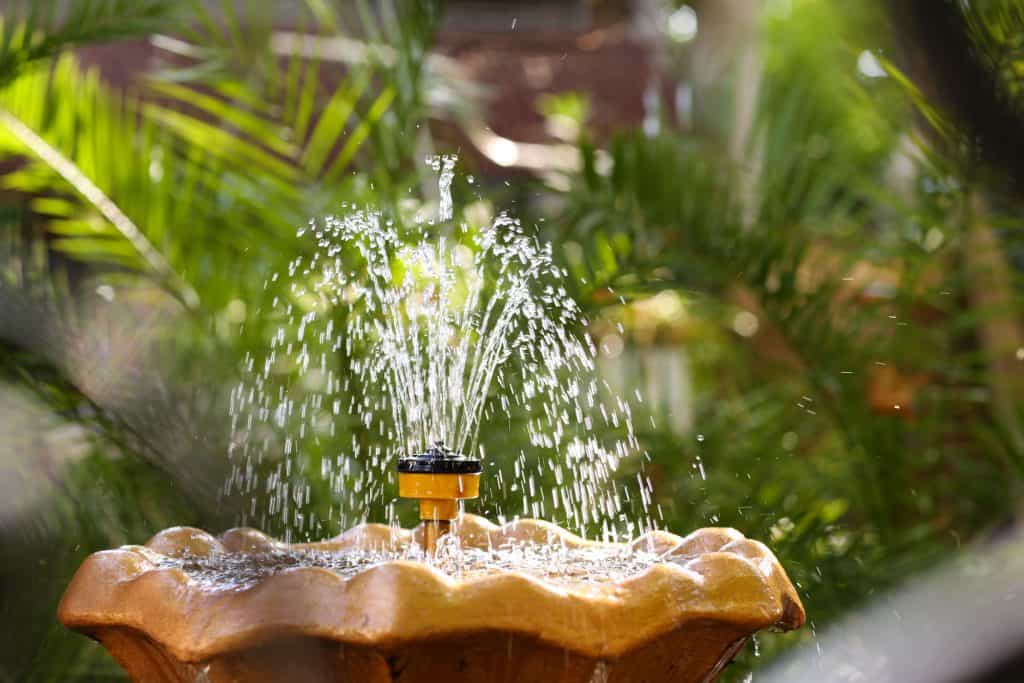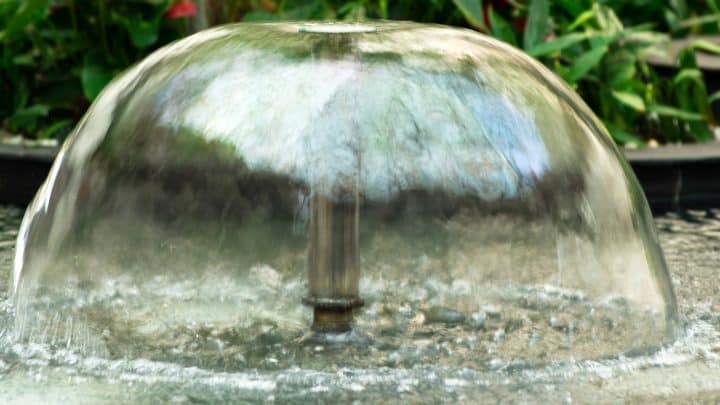Outdoor water fountains can bring a calming effect on your garden, improve the garden’s aesthetics and attract birds and other wildlife. There’s nothing better than listening to the rippling sound of the water while relaxing in your garden.
Water fountains use minimal electricity and don’t need a lot of maintenance, but can you leave your water fountain running all the time?
You can leave your outdoor water fountain constantly running as long as you ensure a consistent water supply and clean the fountain regularly. Outdoor water fountains run on submerged water pumps that should be left running for optimal water flow.
This article will discuss why you should keep your water fountain constantly running and the harmful effects of turning off the water fountain pump. It will also look at common problems people face with water fountains and how to maintain them properly. So let’s get into it!
Should You Turn Off Your Outdoor Water Fountain?
You shouldn’t turn off your outdoor water fountain since they run continuously by design. Turning off the water pump often will cause it to get damaged faster. It may also cause other issues associated with stagnant water.
Since outdoor fountain water pumps are run on slow settings, they don’t get damaged easily and can run for several years without replacing them.
You can turn off your water pump for maintenance and fix the pump, but don’t turn it on and off daily. Some water pumps can get jammed if turned on and off constantly.
What Happens if You Leave an Outdoor Water Fountain Off?
Leaving your outdoor water fountain off can cause stagnant water and algae growth, leading to pest breeding and other issues. Frequently turning your fountain off can also damage the fountain and the water pump.
Stagnant water in water features can contribute to pest breeding, especially among egg-laying insects in the warmer months. It can also result in diseases spreading faster. Algae and other weeds can also grow due to stagnant water. If you have fish in the fountain, the stagnant water could harm the fish’s health.

Running water is always cleaner will prevent algae, which is why a flowing river or stream will always be cleaner than a stagnant marsh or pond. The same is true for your outdoor water fountain. So, if you want to keep your fountain clean, disease-free, and prevent algae buildup, keep it flowing constantly.
If you’ve left your outdoor fountain stagnant for a long period, the water feature has probably started to develop an odor. Fear not — we’ve covered how to keep your fountain from smelling in this article.
How Long Before Outdoor Fountains Grow Stagnant?
Stagnation can occur in most fountains in as little as 24 hours. So you don’t have long before algae growth appears, and the still water invariably attracts adult mosquitoes. Once the mosquitoes are there, the egglaying will begin.
As mentioned above, this is primarily a consideration in the warmer months. However, leaving the water in your water feature stagnant is a bad idea no matter the month.
Can You Turn Off Outdoor Water Fountains in Winter?
You shouldn’t turn the fountain off in the winter as it could cause the water to freeze. Choosing to turn it off may, in turn, damage the pump. Frozen water could also damage the stone, marble, or other fountain material.
If you live in a frigid area, you may need to turn the fountain off in winter. Before doing so, make sure to drain the water altogether to avoid motor damage.
You should also carefully remove the pump and store it in a warm place. Doing so will help you avoid damaging your pump and allow you to easily re-install the pump in the spring.
What About Indoor Fountains?
So far, we’ve only discussed outdoor fountains — water features, garden fountains, and the like. However, the outdoors aren’t the only place where you may have your fountain. For example, should an indoor water fountain stay running constantly?
Generally, there is no problem leaving an indoor fountain pump running all the time. The pumps are small and designed for constant use. However, you should keep fresh water in the feature and used distilled water to prevent mineral buildup on the surface.
How Should You Maintain Outdoor Water Fountains?
Keep your water fountain clean by doing daily maintenance and have it cleaned by a fountain cleaning expert at least twice a year, preferably without harsh chemicals. If you have a skimmer net and filter pads, you’ll only have to clean them twice a week.
When doing a maintenance checkup of your outdoor water fountain, make sure of the following:
- The water pump should have optimal output power.
- The filter pads and skimmer net should be clean.
- The water level should be high enough to not damage your pump. Consider looking into auto fill fountains if this is a problem for you.
- If the fountain has an autofill feature, make sure it’s at the correct setting.
- If calcium deposits are an issue, clean the entire fountain using calcium lime remover and replace the water with distilled water instead of tap water to prevent the issue from happening again.
Additionally, you may want to have your water features tested by a professional at least once or twice a year. They will check the water level, adjust the water pump settings, and ensure that the correct level of helpful bacteria and algae are present in the water.
Fortunately, most water fountains require minimal maintenance if the water flows consistently. However, if the water’s stagnant, you’ll have to clean it more often.

Do Water Fountains Use a Lot of Electricity?
Water fountains don’t use a lot of electricity, especially the smaller ones. The typical water fountain runs on a light water pump that uses as much electricity as a light bulb or two. Some energy-saving water fountain pumps are designed to run on solar panels and are entirely self-sufficient.
Running an outdoor fountain constantly won’t use a lot of electricity, and the effect on your bill will be barely noticeable. To reduce electricity waste caused by water fountains, you can get an energy-friendly fountain or use an energy-saving pump. If you’re curious about how much an outdoor water fountain costs to run, we wrote about that here.
Recommended Outdoor Fountain Pumps
Here are the top 3 water pumps to use in your outdoor water feature:
- Aquagarden Universal Fountain Pump (available on Amazon.com, affiliate link): With minimal inlet blockages and a 75 gallon per hour (283.9 liter/hour) flow rate, this is one of the top affordable water fountain pumps.
- AQUANIQUE Auto-Off Fountain Pump (available on Amazon.com, affiliate link): With a built-in low water sensor and a flow rate of 140 gallons per hour (529.95 liter/hour), this is one of the most effective water pumps at an affordable price. You’ll never have to worry about evaporating water damaging the pump with this pump.
- Alpine Cyclone Pond Pump (available on Amazon.com, affiliate link): With an impressive 3,100 gallons per hour (11,734.78 liter/hour) flow rate, this is one of the strongest pumps for your fountain or waterfall. With energy-saving features and an easy-to-maintain design, it’s the most versatile water pump you can get.
Keeping Your Water Fountain Full
Since sunlight can cause the fountain’s water to evaporate, you’ll need to refill it daily. Some fountains have an auto-refill option which allows you to connect the fountain with your home water supply. You may have to manually fill them when the water drops below a certain level with others.
When refilling your fountain, try to use distilled water. While there’s no significant harm in using tap water in a water fountain, it could cause discoloration or weaken the fountain over time. Distilled water will help keep your fountain cleaner and prevent long-term damage.
Another ingenious method to reduce water evaporation is to replace a spray fountain with a trickle pump. The trickle pump is also more energy-efficient.
Lastly, try to place your outdoor water fountain in a shaded area to prevent evaporation.
Do Outdoor Water Fountains Attract Mosquitoes?
Outdoor water fountains, especially garden fountains, can attract adult mosquitoes who may lay eggs in the water. However, mosquitoes hardly lay eggs in flowing water, so keeping the fountain running may prevent mosquitoes from spreading.
Fountains can also attract frogs and other insects, which may be a nuisance for some people. However, these insects are essential to maintaining a balanced ecosystem. Mosquitoes will attract birds that feed on them, and your garden will soon turn into a thriving ecosystem.
To prevent mosquito larvae from thriving, make sure water flows constantly and your fountain pump is maintained. Since many of these pests only lay eggs in stagnant water, you won’t have to worry about mosquitoes or other pests.
Conclusion
Outdoor water fountains can enhance your garden and attract birds and other wildlife. To keep the fountain clean and the water pump in good condition, keep the fountain flowing constantly. Also, clean the water fixture regularly to prevent dirt, algae, and pests from spreading.
You can turn off your outdoor fountain in winter, but make sure you protect the water pump by draining the water properly before you disconnect the pump.
Sources
- Gardeners Yards: Should I Leave My Water Fountain ON All The Time?
- Find My Answer: Can you run a fountain in the winter?
- Wiki Live: Should I Leave My Water Fountain On All The Time?
- Find My Answer: Do you leave water features on all the time?
- Captain Patio: Outdoor Fountain Water Conservation Guide
- Global Spec: Fountain Pump Selection Guide
- Service Master: Stagnant Water: Why It’s Dangerous and How To Get Rid of It
- This Mama Loves: 7 Ways To Attract Mosquito Eating Birds

